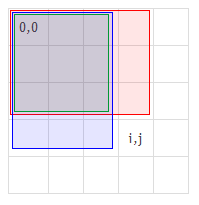Spaceship landing strip (Scientific Expedition) - 最大の着陸場を探せ
どんな問題?
Spaceship landing strip
http://www.checkio.org/mission/spaceship-landing-strip/
地形データから、最大の着陸場を探せ。
地形には、草地、岩、水、低木、高木の5種類あり、草地と低木は整地可能である。
整地可能な地形のみでできた最大の長方形を探し、その面積を求めよ。
地形コード
| G | grass | 草地 | ○ |
| R | rock | 岩 | × |
| W | water | 水 | × |
| S | shrubs | 低木 | ○ |
| T | trees | 高木 | × |
ようするに、地形データから、GとSのみで作られる最大の長方形を探す問題。
引数は、文字列のリストで地形データが渡される。
戻り値は、最大の着陸場の面積を返す。
マップの大きさは縦横10未満。
例題:
checkio(['G']) == 1 checkio(['GS','GS']) == 4 checkio(['GT','GG']) == 2 checkio(['GGTGG','TGGGG','GSSGT','GGGGT','GWGGG','RGTRT','RTGWT','WTWGR']) == 9
どうやって解く?
整地可能なマス(GとS)のみで作られる最大の長方形をどうやって探せばいいだろうか?
マップサイズもそれほど大きくないので、総当たりでチェックするとしよう。
長方形は、左上の点(始点)と右下の点(終点)で定義できるので、
- すべてのマスから1つのマスを選んで始点とする
- 始点の右下方向にあるマスから1つ選んで終点とする
- 長方形が整地可能なら、その面積を取得する
- すべての長方形を調べて、最大の面積を求める
という流れかな。
まず、長方形の中のすべてのマス(座標)を列挙する関数を作成した。
def enum_pts_in_rect(left_top, right_bottom): for y in range(left_top[1], right_bottom[1] + 1): for x in range(left_top[0], right_bottom[0] + 1): yield x, y
指定のマスが整地可能かどうかは、
def can_land(pt): return landing_map[pt[1]][pt[0]] in 'SG'
でチェックする。
始点(src)から、最大の長方形の面積を取得する関数はこちら。
def get_max_area(src): result = 0 # 始点からマップ右下までのマスが、終点の候補 for dest in enum_pts_in_rect(src, map_right_bottom): # 長方形の中のマスをリストアップ pts = list(enum_pts_in_rect(src, dest)) if all(can_land(pt) for pt in pts): # すべてのマスが整地可能なら result = max(result, len(pts)) # マスの数=面積 return result
まとめたのがこちら
def enum_pts_in_rect(left_top, right_bottom): # Yields (x,y) in rect for y in range(left_top[1], right_bottom[1] + 1): for x in range(left_top[0], right_bottom[0] + 1): yield x, y def checkio(landing_map): def can_land(pt): return landing_map[pt[1]][pt[0]] in 'SG' def get_max_area(src): result = 0 for dest in enum_pts_in_rect(src, map_right_bottom): pts = list(enum_pts_in_rect(src, dest)) if all(can_land(pt) for pt in pts): result = max(result, len(pts)) return result map_right_bottom = len(landing_map[0]) - 1, len(landing_map) - 1 return max(get_max_area(pt) for pt in enum_pts_in_rect((0, 0), map_right_bottom))
http://www.checkio.org/mission/spaceship-landing-strip/publications/natsuki/python-3/first/
クリア&公開!
ちょっと書き直してみた。
見直すと、なんか読みにくい気がするので、ちょっと修正。
def checkio(landing_map): def pts_in_rect(start, end): # Yields (x,y) in rect for y in range(start[1], end[1] + 1): for x in range(start[0], end[0] + 1): yield x, y def can_land(rect): return all(landing_map[pt[1]][pt[0]] in 'SG' for pt in pts_in_rect(*rect)) def get_area(rect): return len(list(pts_in_rect(*rect))) map_end = len(landing_map[0]) - 1, len(landing_map) - 1 rects = [(start, end) for start in pts_in_rect((0, 0), map_end) for end in pts_in_rect(start, map_end)] return max(get_area(rect) for rect in rects if can_land(rect))
うーん、改めて公開するほどでもないか。
他の人の答え
最初よくわからなかったのがこちら。
def checkio(a): """ A plain O(N^2*M^2) algorithm, where c[i][j] is the number of obstacles in the rectangle from the top-left corner to (and including) (i, j). """ n, m = len(a), len(a[0]) c = defaultdict(int) for i in range(n): for j in range(m): c[i,j] = c[i-1,j] + c[i,j-1] - c[i-1,j-1] if a[i][j] in "WRT": c[i,j] += 1 best = 0 for i1 in range(-1, n): for j1 in range(-1, m): for i2 in range(i1+1, n): for j2 in range(j1+1, m): if c[i2,j2] - c[i1,j2] - c[i2,j1] + c[i1,j1] == 0: best = max(best, (i2-i1)*(j2-j1)) return best
http://www.checkio.org/mission/spaceship-landing-strip/publications/nickie/python-3/simple-on2m2/
最初に、c[i,j]というdictを作成している。コメントにあるように、c[i,j]は、マップ左上から自分(i,j)までの長方形内の障害物の数となる。
このdictを作成するのが、この部分。
c[i,j] = c[i-1,j] + c[i,j-1] - c[i-1,j-1] if a[i][j] in "WRT": c[i,j] += 1
[i-1,j]は一つ上のマス、[i,j-1]は左隣のマス、[i-1,j-1]は左上のマスとなる。
下の図でいえば、c[i-1,j]は赤いエリアの障害物の数、c[i,j-1]は青いエリアの障害物の数、c[i-1,j-1]は緑のエリアの障害物の数となる。
だから、赤+青-緑 そして、[i,j]が障害物なら+1することで、c[i,j]が求められるというわけだ。

こうして、各マスごとに障害物の数を調べておけば、左上(i1,j1)、右下(i2,j2)の長方形の障害物の数は、
c[i2,j2] - c[i1,j2] - c[i2,j1] + c[i1,j1]
で求められる。
この方法だと、障害物のチェック回数が減るので効率的ということらしい。
なんだか、昨日の The pseudo-polynomial algorithm にも、似ている気がする。
いやー、こんなの自分では絶対に思い付けない。勉強になった。